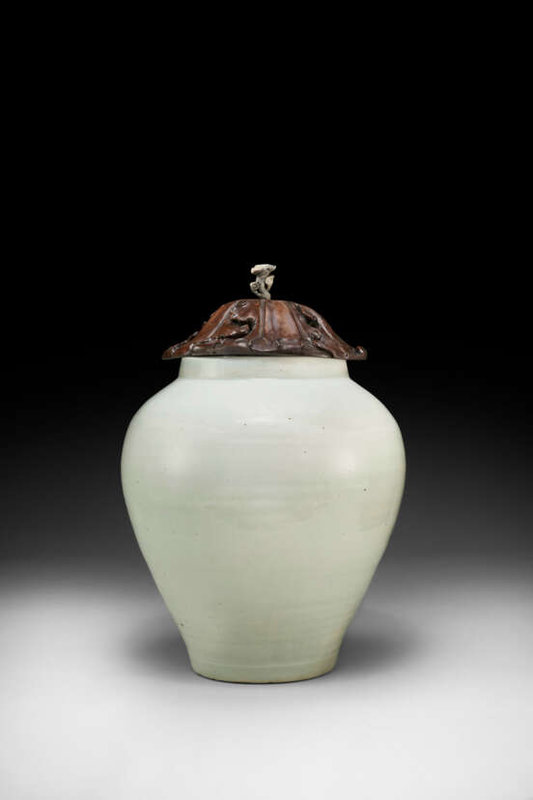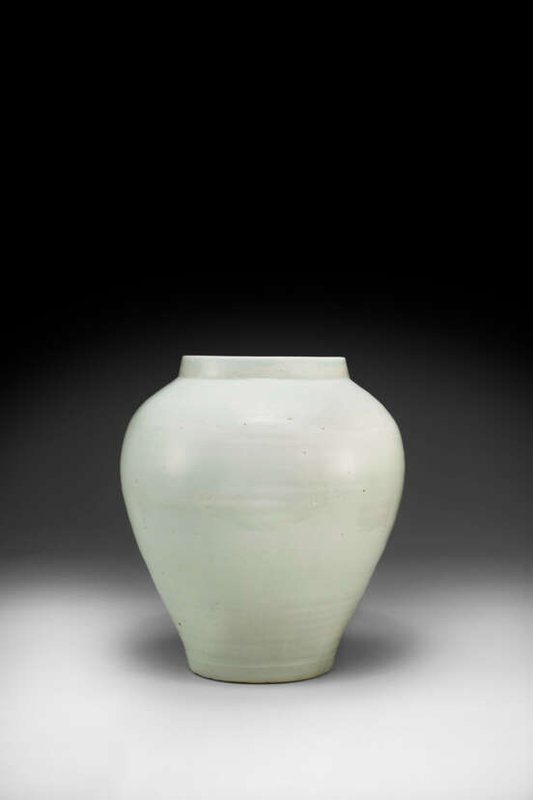The heavily-potted high-shouldered jar is covered overall with a fine 'sweet white' glaze shading to pale greenish-blue, with the base and bottom of the foot left unglazed.
Provenance: J. J. Lally & Co., New York, no. 4291.
Literature: J. J. Lally & Co., Chinese Ceramics in Black and White, New York, 2010, no. 34.
Exhibited: New York, J. J. Lally & Co., Chinese Ceramics in Black and White, 20 March-10 April 2010.
Note: This jar is a rare example of the so-called tianbai (sweet white) glaze applied to a large vessel. The slightly matte, silky tianbai glaze was developed in the Yongle reign (1403-25) in response to the emperor's preference for white porcelains and his desire to have fine white wares both for use in the Palace and for ceremonial purposes. Excavations at the site of the Imperial kilns have shown that by far the greatest proportion of imperial porcelains made during the Yongle reign were white. Even in the Xuande reign (1426-35), when imperial production was dominated by underglaze blue-decorated wares, fine tianbai white wares were highly prized by the court. Few surviving white vessels from either reign period, however, match the large size of the current jar.
An early Ming ‘sweet white’-glazed jar of slightly larger size than the present jar, with lotus-leaf shaped porcelain cover, in the collection of the Nanjing Museum, is illustrated by Xu Huping in The Treasures of the Nanjing Museum, Hong Kong, 2001, p. 56, no. 39. Another slightly larger white jar of similar shape to the current example was excavated from the Xuande strata of the Imperial kilns at Jingdezhen in 1983, illustrated in Imperial Porcelain of the Yongle and Xuande Periods Excavated from the Site of the Ming Imperial Factory at Jingdezhen, Urban Council, Hong Kong, 1989, pp. 212-3, no. 65. See, also, another smaller guan of closely related form, with dragons lightly engraved under a ‘sweet white’ (tian bai) glaze, excavated from the site of the Ming imperial kilns at Jingdezhen and dated to the Yongle period, illustrated in Yuan and Ming Imperial Porcelains Unearthed from Jingdezhen, Beijing, 1999, p. 146, no. 95.
Christie's. J. J. Lally & Co., New York, 23 march 2023

/https%3A%2F%2Fprofilepics.canalblog.com%2Fprofilepics%2F1%2F0%2F100183.jpg)
/https%3A%2F%2Fstorage.canalblog.com%2F03%2F02%2F119589%2F96711876_o.jpg)
/https%3A%2F%2Fstorage.canalblog.com%2F11%2F31%2F119589%2F94773502_o.jpg)
/https%3A%2F%2Fstorage.canalblog.com%2F20%2F83%2F119589%2F94772815_o.jpg)
/https%3A%2F%2Fstorage.canalblog.com%2F26%2F72%2F119589%2F75604929_o.jpg)
/https%3A%2F%2Fstorage.canalblog.com%2F59%2F60%2F119589%2F26458628_o.jpg)




/http%3A%2F%2Fstorage.canalblog.com%2F49%2F27%2F119589%2F129412339_o.jpg)
/http%3A%2F%2Fstorage.canalblog.com%2F45%2F44%2F119589%2F129231865_o.jpg)
/http%3A%2F%2Fstorage.canalblog.com%2F68%2F34%2F119589%2F127775703_o.jpg)
/http%3A%2F%2Fstorage.canalblog.com%2F27%2F11%2F119589%2F127775565_o.jpg)